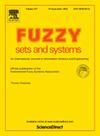具有概率集的保守决策:如何从先前的选择中推断出新的选择
IF 2.7
1区 数学
Q2 COMPUTER SCIENCE, THEORY & METHODS
引用次数: 0
摘要
当决策者的不确定性由一组概率质量函数描述时,我们研究了期望效用最大化的广义版本,称为e -可容许性,以做出决策。特别是,我们没有直接指定这个集合,而是假设我们只有关于决策者偏好或选择的部分信息,即她从一些有限的选项集合中拒绝哪些选项。我们使用选择函数描述决策过程和可用信息,并提供了一种基于线性规划的算法,以计算给定选择评估对基于e -可接受性做出决策的选择函数的最保守扩展。接下来,我们将这个e可容许扩展与所谓的相干扩展联系起来,并展示如何用同样的技术来简化这个相干扩展的计算也可以用来简化e可容许扩展的计算。在实验中,我们证明了使用e -可接受扩展的决策比使用连贯扩展的决策更快,信息量更大,但也观察到一旦问题规模的参数增加,所需的计算就会变得具有挑战性。本文章由计算机程序翻译,如有差异,请以英文原文为准。
Conservative decision-making with sets of probabilities: How to infer new choices from previous ones
We study a generalized version of maximizing expected utility, called E-admissibility, to make decisions when the decision-maker's uncertainty is described by a set of probability mass functions. In particular, instead of specifying this set directly, we assume that we only have partial information about the decision-maker's preferences or choices, in the form of which options she rejects from some finite sets of options. We describe both the decision-making process and the available information using choice functions, and we provide an algorithm, based on linear programming, to compute the most conservative extension of a given choice assessment to a choice function that makes decisions based on E-admissibility. Next, we relate this E-admissible extension to the so-called coherent extension and show how the same techniques that are used to simplify the computation of this coherent extension can also be used to simplify that of the E-admissible one. In our experiments, we demonstrate that decision-making with the E-admissible extension is faster and more informative than with the coherent one, but also observe that the required computations are challenging once the parameters of the problem scale.
求助全文
通过发布文献求助,成功后即可免费获取论文全文。
去求助
来源期刊

Fuzzy Sets and Systems
数学-计算机:理论方法
CiteScore
6.50
自引率
17.90%
发文量
321
审稿时长
6.1 months
期刊介绍:
Since its launching in 1978, the journal Fuzzy Sets and Systems has been devoted to the international advancement of the theory and application of fuzzy sets and systems. The theory of fuzzy sets now encompasses a well organized corpus of basic notions including (and not restricted to) aggregation operations, a generalized theory of relations, specific measures of information content, a calculus of fuzzy numbers. Fuzzy sets are also the cornerstone of a non-additive uncertainty theory, namely possibility theory, and of a versatile tool for both linguistic and numerical modeling: fuzzy rule-based systems. Numerous works now combine fuzzy concepts with other scientific disciplines as well as modern technologies.
In mathematics fuzzy sets have triggered new research topics in connection with category theory, topology, algebra, analysis. Fuzzy sets are also part of a recent trend in the study of generalized measures and integrals, and are combined with statistical methods. Furthermore, fuzzy sets have strong logical underpinnings in the tradition of many-valued logics.
 求助内容:
求助内容: 应助结果提醒方式:
应助结果提醒方式:


